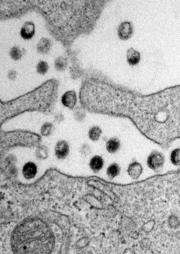Novel sensing mechanism discovered in dendritic cells to increase immune response to HIV

Dendritic cells are the grand sentinels of the immune system, standing guard 24/7 to detect foreign invaders such as viruses and bacteria, and bring news of the invasion to other immune cells to marshal an attack. These sentinels, however, nearly always fail to respond adequately to HIV, the virus causing AIDS. Now a team of scientists at NYU Langone Medical Center has discovered a sensor in dendritic cells that recognizes HIV, spurring a more potent immune response by the sentinels to the virus. They report their findings in the September 9, 2010, issue of Nature.
"This is the first time that an alarm system that recognizes retroviruses like HIV has been discovered," says Dan Littman, MD, PhD, the Helen L. and Martin S. Kimmel Professor of Molecular Immunology in the Departments of Pathology and Microbiology at NYU Langone Medical Center and a Howard Hughes Medical Institute investigator, and the study's lead author.
"The ability to stimulate a protective immune response against HIV is critical to the development of therapeutic or preventive vaccines for the virus," says Dr. Littman. In contrast to normal vaccines, which prevent infection, therapeutic vaccines are designed to boost the severely weakened immune systems of people infected with HIV.
Dendritic cells, named for their branching, tree-like shape, have been called the maestros of the immune system because they orchestrate a dynamic range of immune responses. These cells have attracted intense interest from researchers in many fields because of their potential to fight disease and prevent rejection of organ transplants.
When a dendritic cell captures a dangerous pathogen, it tears it apart and delivers a piece to the soldiers of the immune system cells, called T-cells, which in turn expand like a clonal army to coordinate immune defenses and destroy the invader. But dendritic cells fail to recognize HIV as a danger. Instead, HIV exploits the cells to get a free ride to T-cells, which become infected with the virus. "The virus actually infects the same soldiers that are supposed to protect us from it," explains co-author Derya Unutmaz, MD, associate professor in the Departments of Microbiology, Pathology and Medicine at NYU Langone Medical Center.
Although HIV enters dendritic cells, an unknown mechanism blocks the virus from infecting them—going into the nucleus of the cells to make copies of itself. Recently, a technique was discovered to overcome this block by bathing the cells with a protein derived from SIV, a relative of HIV that only infects monkeys. Using these techniques, the researchers discovered that when HIV was forced to enter the nucleus of dendritic cells, the cells unexpectedly recognized the virus as an intruder and went into action to initiate a program to stimulate a stronger T-cell response against the virus.
What set off the alarm, the researchers found, was a protein called capsid, which encapsulates HIV's genetic material. "It's surprisingly unexpected that the sensing mechanism of the dendritic cell recognizes the capsid of the virus, rather than the genetic material inside," says co-author Nicolas Manel, PhD, of The Kimmel Center for Biology and Medicine at the Skirball Institute at NYU Langone Medical Center and the Institut de Genetique Moleculaire de Montpellier. "Nevertheless, by adding elements of this capsid to a vaccine," says Dr. Manel, "it may be possible to improve the immune response of those who already have HIV or actually mount a potent immune response before the individual is infected."
"We still don't understand why this sensor is triggered only when we force HIV to integrate into dendritic cell genome to make its own copies," adds Dr. Unutmaz. "One possibility is that this cryptic sensing mechanism has evolved to recognize the thousands of ancient retroviruses that have infected us in the past and now make up almost 10% our genome. It is conceivable that dendritic cells have evolved this internal sensor in case any of these archaic retroviruses were reawakened. Nonetheless, the finding is extremely exciting because not only it could lead to new directions in HIV vaccine research but it can also be exploited to enhance vaccines against other viruses."















